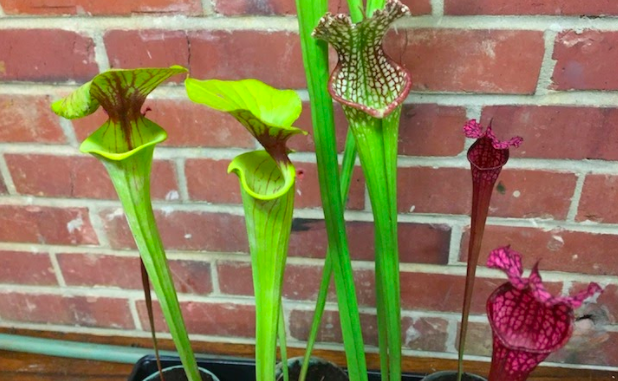
-Pam Scott-
Do you remember being a kid and finding out that there are plants that eat animals? Chances are you probably thought that was, without a doubt, the coolest thing in the entire world. Every day we have children coming into the shop, bursting with excitement to see our carnivorous plants. The fact is that many of us at Fifth Season consider carnivorous plants to be the coolest plants on earth.
Carnivorous plants are bog plants that have evolved to live in low nutrient, highly acidic, wet environments. There are over 750 species of carnivorous plants world wide. Instead of taking their nutrients from the soil like most plants, they trap, kill and digest insects, frogs, fish and even small mammals to fulfill their nutritional needs.
Different species of carnivorous plants employ ingenious ways of trapping their meals. Some pitcher plants have long tubes rimmed with a narcotic called Conine that attracts and drugs insects, which fall into the tube that is lined with downward pointing hairs making escape impossible. There they die and are digested by the plant.

Sundews have a sticky mucilage that attracts and traps the bugs, triggering the plant to curl around the insect, strangling and digesting it. Bladderworts are water plants that have chambers that are triggered to open with the movement of bugs or fish and suck them in. As the trapped animal tries to struggle free, the plant is triggered to produce digestive enzymes that will dissolve the animal.
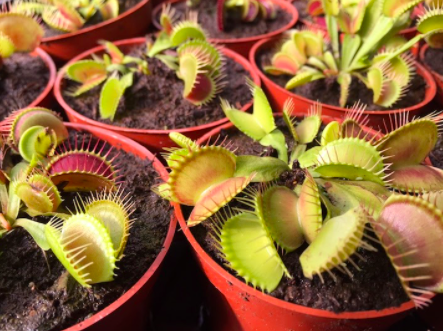
The most popular of the carnivorous plants is the Venus Fly Trap, Dionaea muscipula. The Venus Fly Trap has a sweet smelling nectar that attracts bugs into its traps. If the bug touches two or more of the trigger hairs inside of the trap, the trap will quickly shut around the bug. As the bug struggles, touching more trigger hairs, the plant is prompted to produce digestive enzymes that will kill and dissolve the bug.
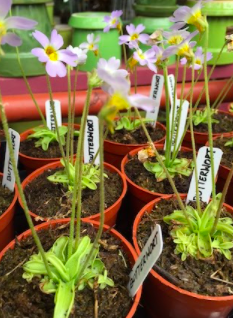
Carnivorous plants need to be pollinated by insects in order to reproduce.They cleverly avoid eating their pollinators by producing flowers that bloom high above their deadly leaves.
Venus Fly Traps, tropical Nepenthes pitcher plants, and Sarracenia pitcher plants are some commonly found, easy-care carnivores. There are some very specific needs that these plants have in order to survive, but if you follow these few basic guidelines you should be able to successfully grow carnivorous plants.
Choose a sunny spot for your plants year-round. They can go outdoors in the spring and summer. Carnivorous plants are bog plants that need to be moist all of the time. Place their pot in a tray with a bit of water in the bottom. The water you use must be distilled or rain water. This is very important; no tap water. Do not keep the pot completely submerged in water as the roots still need oxygen to survive.
The temperate climate carnivores, Sarracenia and Venus Fly traps that are found in the mid Atlantic and northern states, need a cold dormant period from November to February. Keep them in the sunny window of a garage, a shed, or an unheated greenhouse with plenty of light and a bit less water. The Venus Fly Traps will turn black and begin to form new growth again in the spring.
Never fertilize your carnivorous plants. If you can’t help yourself and feel you must feed your Venus Fly Traps, you can give them no more than one dried mealybug in one trap per plant once a week. Use a toothpick to stimulate the trigger hairs in order to produce digestive enzymes. If you don’t, the bug will rot along with the trap. If you feel that your plants are not getting enough to eat you can put them outside on a warm day and they will attract their own food.
Avoid the temptation to poke your finger in your Venus Fly Traps. Though each plant will have multiple traps, each trap will only close 5 times in its lifetime. Closing the traps takes a large amount of energy away from the plant, if it closes with no food to bolster its resources the plant will suffer.
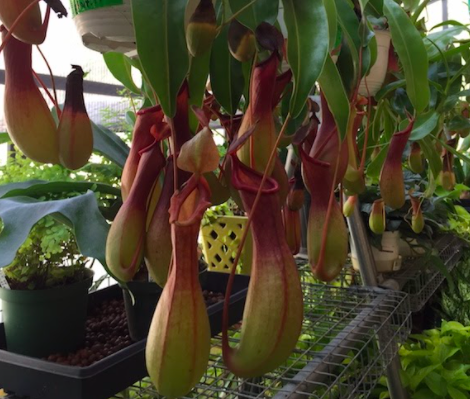
Pour a bit of rain water in the pitchers of your Nepenthes and Sarracenia. This will aid in digestion, fill the pitchers no more than ¼ of the way up. Pitcher plants that have a highly humid environment will produce their own water in their pitchers.
If you want to transplant your carnivorous plants, you can use a mixture of plain, non-limed peat moss mixed with horticultural sand or perlite, 2:1.
Now for the not so fun facts about carnivorous plants. In the wild, all carnivorous plants have become severely endangered. This is due to habitat destruction and poaching. The native habitat of the Venus Fly trap is within a 100 mile radius of Wilmington, North Carolina; this is its only native habitat on earth. Thankfully, it has become a felony to poach these plants, but there are many other species that don’t have such protections. Native temperate carnivores are suffering from habitat loss and poaching all along the east coast of the United States. Almost all carnivorous plants can be propagated from tissue culture and seed, so there is really no reason to take them from the wild. When buying a carnivorous plant make sure you are buying from a reputable supplier.
There are some ways to tell if a plant has been propagated or poached. Check to see if the soil looks like a sterile peat mix or if the soil is full of gravel, twigs and natural ground soil, the gravely natural soil plants may be poached. Notice if all the plants in the tray are of uniform size shape and color, this can indicate a sustainable tissue culture propagation. Notice if there are any weedy plants or other other carnivorous species in the pot, indicating a possibly poached plant. Fifth Season sells only tissue culture plants.
Carnivorous plants are not only fascinating botanical wonders, they are an essential element in the health of our bogs as well as the ecosystem of our planet.
Drop by Fifth Season for a visit and to take care of all of your plant, soil and potting needs!
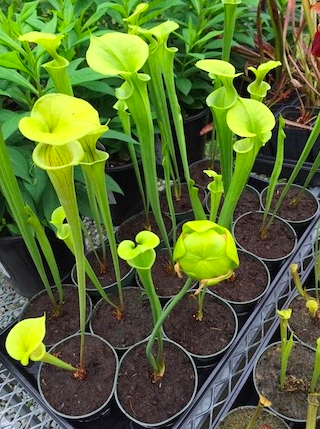

Marvin Reed says
Great info.
I just bought three venus flytraps.. They are beautiful eat bugs just fine.